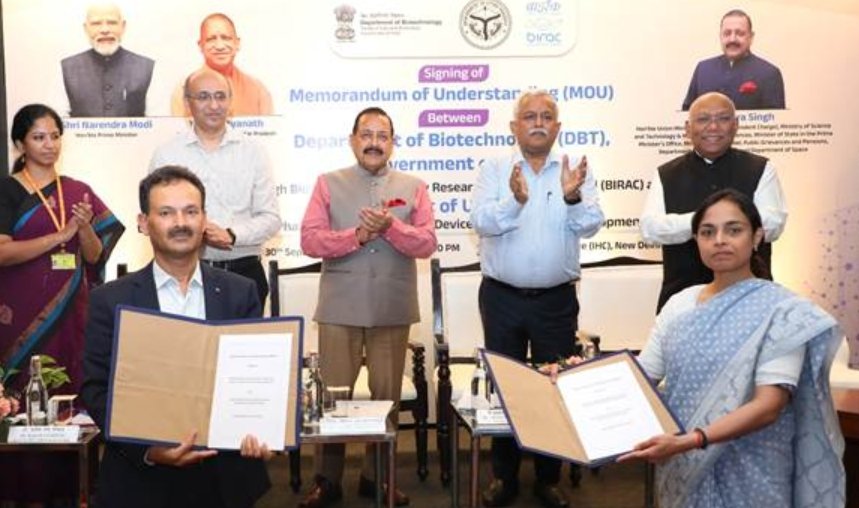Fuel of the future: A success story
October 10, 2011 | Monday | News
Karnataka’s first-of-its kind biofuel
park in Hassan has set an example
for others. With the extension of the project to the entire state, it
expects to generate revenue of about  1,100 crore per year and, also
save on the oil bill
1,100 crore per year and, also
save on the oil bill

In 2006, the University of Agricultural Sciences,
Bangalore, initiated
a biofuel park project at Madenur in Hassan district of Karnataka to
encourage the biofuel industry. The local farmers were supplied
saplings of Pongemia, Simarouba, Neem, Jatropha and Mahua, tree species
that produce non-edible oilseeds, worth

14.25 lakh free of cost.
Today, the farmers are reaping the benefits of the crop, while the
project’s success has led other states of India, like Chhattisgarh,
Orissa, Jharkhand, Gujarat and Madhya Pradesh, and countries, like The
Netherlands and Denmark, to follow the example.
Energy
scenario
in
India
India’s energy demand is expected to grow at an annual
rate
of 4.8
percent over the next couple of decades. As much as 34 percent of the
Centre’s financial budget is allocated to import of petroleum fuels
with over  3.75 lakh crore being spent on their purchase. The biofuel
policy was passed in India in 2009, which aimed for 20 percent blending
of biofuels, that is either bioethanol or biodiesel, in petroleum fuels
by 2017. Keeping this in mind, many state governments have initiated
various programs to achieve these objectives.
3.75 lakh crore being spent on their purchase. The biofuel
policy was passed in India in 2009, which aimed for 20 percent blending
of biofuels, that is either bioethanol or biodiesel, in petroleum fuels
by 2017. Keeping this in mind, many state governments have initiated
various programs to achieve these objectives.
The decentralized initiative is reminiscent of the co-operative
movement involved in the procurement of milk. By extending the project
to the entire state, the government expects to generate reveue of about

1,100 crore per year and save foreign exchange.
The farmers planted the saplings in the backyards of their houses, on
bunds and wastelands. Today, there are 430 farmers’ associations for
collection of oilseeds and the farmers are paid an amount above the
minimum support price fixed by the government.
The first-of-its-kind initiative
Karnataka has been known for setting benchmarks in new areas of
businesses, such as information technology and biotechnology. In March
2009, it became the first state in the country to announce the State
Biofuel Policy in line with the National Biofuel Policy of the
Government of India announced on September 12, 2008.
Though the policy was announced only in 2009, the Karnataka government
had taken many initiatives to encourage the biofuel industry even
before the policy was announced. The Hassan project, 194 kms from
Bangalore, was one of them. The project is the first-of-its-kind
initiative in the country and Hassan district was chosen for its
variety of climatic conditions that is similar to most parts of the
country.
Aims of Hassan Biofuel Park
- Utilization of 5.62 lakh hectare of agriculture land for
plantation
on bunds and 0.28 lakh hectare of degraded land for mixed plantation in
Hassan district. A farmer gets
 200-to-
200-to- 2,000 as extra income.
Approximately, 50-60 man-days of employment is generated per year per
family
2,000 as extra income.
Approximately, 50-60 man-days of employment is generated per year per
family
- By growing five plants per hectare in agriculture land on
bunds and approximately 70 plants in wastelands, 29,000 tons of seeds
and 8,800 tons of oil can be obtained after six years
- Environmental
protection and soil moisture conservation
- Marketing of oil at the rate of
 30,000 per ton is
expected to
fetch
30,000 per ton is
expected to
fetch
 30 crore
30 crore
A co-operative initiative
This initiative, which aimed to provide an additional means for
sustenance to farmers, will eventually help create a network for the
procurement of oilseeds for the biofuel industry. Dr BalaKrishna Gowda,
project co-ordinator at Hassan Biofuel Park, explains, “This approach
requires very little effort from the farmer who gains additional income
via products, such as oilseeds, and enjoys a high rate of success
because they are directly involved in the process.” He said that there
are 70 biofuel villages in the district and each household grows any
one of the given tree species.
In addition to providing saplings, the biofuel park is also associated
with innovations in the machinery involved in biofuel production and
the transfer of this technology directly to the farmers.
Dr Gowda said more than 1,150 awareness meetings and training programs
have been conducted in the last few years involving over 70,000
farmers. “As many as 50 percent of them were women participants. These
farmers had planted about 14.5 lakh seedlings over 15,000 acres of land
in Hassan district,” he elaborates.
Dr Gowda adds that the decentralized approach results in less carbon
footprints in the production of biofuels. “Biofuels would lose their
sheen if thousands of litres of fuel were burnt to transport seedstock
from the field to the factory. Hence, biodiesel production units are
being set up at the taluk and district levels to minimize costs and
efforts involved in transportation of seedstock,” he says.
Alternative fuels
Worldwide, Brazil has been at the forefront of producing biofuels since
the 1980s. It is the world’s leading producer of bioethanol and uses
sugarcane to produce it, while some South East Asian countries use palm
oil and the US uses corn and soyabean. To avoid the food versus fuel
debate raging in the West, India has focused on non-edible oilseed
crops and trees that have short gestation period and can be grown in
harsh conditions.
According to Mr Y B Ramakrishna, chairman of the Karnataka State
Biofuel Board, India has a huge potential in the production of
biofuels. Stressing on the need for a proactive government to integrate
production of biofuels with industrial practices, he says, “India is
the largest producer of sugar with Uttar Pradesh, Maharashtra and
Karnataka being the leaders. There is a huge untapped market for
production of bioethanol from molasses produced in the sugar factories.
We are encouraging the factory owners to set up bioethanol production
plants, so that this resource can be effectively utilized.”
Mr Biligiri Kadambi, director of Southern Biofuel Technologies, says,
“Bioethanol has the potential to make a huge industry impact. However,
actively producing and distributing it is not a very viable option
right now because it comes under the liquor bracket and additional
taxes are applicable.”
Biodiesel on the other hand has caught the fancy of entrepreneurs
nationwide. Once the hype surrounding Jatropha died down, researchers
started looking at other non-edible varieties of oilseeds, trees,
shrubs and algae to produce biodiesel. Algae is being looked at with a
lot of interest as they have a high biomass yield per unit of light and
area and do not require agricultural land.
Problems in sourcing seedstock
One of the problems that entrepreneurs face initially is the lack of a
consistent supply network of seedstock and the raw material used to
produce biodiesel. Mr Julesh Bantia, head of Eco Green Fuels who has
established a biodiesel producing unit in Bangalore, says, “The most
important factor for any company in the biofuel industry is the regular
and continuous availability of seedstock. There is a lot of volatility
associated with prices of seedstock, which decide the profits for any
company. Soap industries offer higher prices for seedstock and, hence,
emerge the biggest competitor for seedstock for biofuel industries. The
biodiesel producers cannot compete with these prices due to the high
production costs. The government should take concrete steps to fix the
price of seedstock, so that both parties can benefit.”
Jatropha’s downfall
According to the Biodiesel Mission of 2002, jatropha was planted on
over 50,000 hectares of land in eight states. But the enthusiasm
surrounding jatropha died down due to various reasons:
- Jatropha is a hardy crop and can survive in any
geoclimatic conditions. Hence, it was expected to give high yields
without inputs, such as irrigation and pesticides, but the yield of
seeds in harsh conditions was found to be very low.
The expected number of seeds or the yield was 4-to-16 kg per
tree but the actual number of seeds was found to be 0.4-to-0.5 kg per
tree
- Long gestation period
- Toxic oil cake produced after extraction of oil. One kg
oil produces two-to-three kgs of oil cake
- Seeds are available only for two weeks
Mr Kadambi of Southern Biofuel Technologies said they took some
initiatives to circumvent this problem. “At our facility in Gujarat, we
have our own 1,000 acres of land where we grow crops, like safflower,
castor and argimone, a variety of poppy, which are then used for the
production of biodiesel. As we are in direct contact with the
seedstock, we can make use of the byproducts such as de-oiled cake,
flower petals, among others. These can be further processed to be used
as fertilizers or animal feed or used to generate biogas. These
value-added integrated practices are very essential in helping the
industry survive and grow.”
New initiatives in biofuel sector
Petroleum companies are waking up to the advantages of blending
biofuels and are taking steps to facilitate it on a larger scale.
Bharat Petroleum, in collaboration with Hassan Biofuel Park in
Karnataka, is going to open an outlet to sell blended biodiesel
shortly. The Indian Oil Corporation recently signed a memorandum of
understanding with the Department of Biotechnology, Government of
India, to set up the Centre for Advanced Research on Bio-energy in
Faridabad to work towards developing sound technology to produce
biofuels.
Among the various myths associated with biofuels is the belief that
various engine modifications need to be carried out for their use. Mr
CS Bhaskar, managing director and CEO of Naturol Bioenergy that has 12
retail stations selling biodiesel in Andhra Pradesh, explains that this
was not true. “All engines built after 1996 do not use rubber and hence
no change in the engine of the automobile is necessary. The use of
biodiesel in a conventional diesel engine results in substantial
reduction of unburned hydrocarbons, carbon monoxide, and particulate
matter. It also decreases solid carbon fraction of particulate matter
as the oxygen in biodiesel enables more complete combustion to CO2. For
every ton of biodiesel used, the release of three ton of CO2 is
prevented,” he says.
The cost of biodiesel remains an impediment. Industry experts say the
price, though fluctuates, remains around 15 percent more than diesel.
Subsidies offered on crude oil, which drastically reduces its price
further, prevent biofuels from being able to compete with them. “The
government should either offer similar subsidies to biodiesel or remove
the value added tax on biodiesel,” says Mr Bhaskar.
“Biofuels,
being promoted as an environmentally sound approach, would lose their
sheen if thousands of litres of fuel were burnt to transport seedstock
from the field to the factory. Hence, biodiesel production units are
being set up at the taluk and district levels to minimize costs and
efforts involved in transportation of seedstock”
— Dr Balakrishna Gowda, Project
co-ordinator, Hassan Biofuel Park
“At our facility in Gujarat, we have our own 1,000 acres of land where
we grow crops, like safflower, castor and argimone, a variety of poppy,
which are then used for the production of biodiesel. As we are in
direct contact with the seedstock, we can make use of the byproducts
such as de-oiled cake, flower petals, among others”
— Mr Biligiri Kadambi,
Director, Southern Biofuel Technologies
“India is the largest producer of sugar with Uttar Pradesh, Maharashtra
and Karnataka being the leaders. There is a huge untapped market for
production of bioethanol from molasses in the sugar factories. We are
encouraging the factory owners to set up bioethanol plants, so that
this resource can be effectively utilized.”
— Mr YB Ramakrishna, Chairman,
Karnataka State Biofuel Board
“All engines built after 1996 do not use rubber and hence no change in
the engine of the automobile is necessary. The use of biodiesel in a
conventional diesel engine results in substantial reduction of unburned
hydrocarbons, carbon monoxide, and particulate matter. It also
decreases solid carbon fraction of particulate matter.”
— Mr CS Bhaskar, MD & CEO,
Naturol Bioenergy
— Manasi Vaidya


 In 2006, the University of Agricultural Sciences,
Bangalore, initiated
a biofuel park project at Madenur in Hassan district of Karnataka to
encourage the biofuel industry. The local farmers were supplied
saplings of Pongemia, Simarouba, Neem, Jatropha and Mahua, tree species
that produce non-edible oilseeds, worth
In 2006, the University of Agricultural Sciences,
Bangalore, initiated
a biofuel park project at Madenur in Hassan district of Karnataka to
encourage the biofuel industry. The local farmers were supplied
saplings of Pongemia, Simarouba, Neem, Jatropha and Mahua, tree species
that produce non-edible oilseeds, worth 






